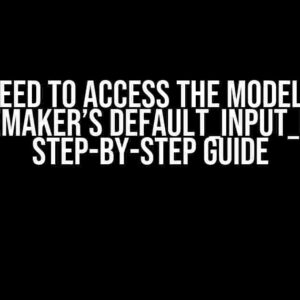Are you tired of encountering the cryptic “Data Cardinality is Ambiguous” error when working with Seq2Seq models? Do you find yourself scratching your head, wondering what this error even means, let alone how to fix it? Fear not, dear reader, for in this article, we’ll delve into the world of encoders, decoders, and target data, and provide a step-by-step guide on how to resolve this frustrating issue.
What is Data Cardinality, and Why is it Ambiguous?
Before we dive into the solution, let’s take a step back and understand what “Data Cardinality” means. In the context of machine learning, data cardinality refers to the number of unique values in a particular feature or column of your dataset. In other words, it’s a measure of the uniqueness of the data.
In Seq2Seq models, data cardinality becomes crucial when dealing with target data, which is the output or response variable that the model is trying to predict. When the target data has ambiguous cardinality, it means that the model is unsure about the number of unique values in the target data, leading to the dreaded “Data Cardinality is Ambiguous” error.
Causes of Ambiguous Data Cardinality
So, what causes this ambiguity in the first place? There are a few common culprits:
- Missing values: When there are gaps or null values in the target data, the model struggles to determine the unique values, leading to ambiguity.
- High cardinality: When the target data has an extremely large number of unique values, the model might have trouble distinguishing between them, resulting in ambiguity.
- Data type issues: If the target data is not properly formatted or has inconsistent data types, it can confuse the model and lead to ambiguity.
- Improper data preprocessing: Failure to preprocess the target data correctly, such as not handling outliers or encoding categorical variables, can result in ambiguous data cardinality.
Fixing the “Data Cardinality is Ambiguous” Error
Now that we’ve identified the causes, let’s get to the solution! Here’s a step-by-step guide to resolving the “Data Cardinality is Ambiguous” error:
Step 1: Inspect and Clean the Target Data
The first step is to examine the target data closely and address any issues that might be causing the ambiguity:
import pandas as pd
# Load the target data
target_data = pd.read_csv('target_data.csv')
# Check for missing values
print(target_data.isnull().sum())
# Drop or impute missing values as needed
target_data.dropna(inplace=True) # or use imputation techniques
# Check data types
print(target_data.dtypes)
# Convert data types as needed
target_data['column_name'] = target_data['column_name'].astype('category')
Step 2: Handle High Cardinality
If the target data has high cardinality, we can use techniques to reduce the number of unique values:
import numpy as np # Calculate the frequency of each value in the target data value_freq = target_data['column_name'].value_counts() # Set a threshold for rare values (e.g., 5% of total samples) rare_threshold = 0.05 * len(target_data) # Replace rare values with a special 'RARE' token target_data['column_name'] = np.where(target_data['column_name'].isin(value_freq[value_freq > rare_threshold].index), target_data['column_name'], 'RARE')
Step 3: Preprocess the Target Data
Properly preprocess the target data to ensure it’s in a format that the model can understand:
from sklearn.preprocessing import LabelEncoder # Create a LabelEncoder object le = LabelEncoder() # Fit the encoder to the target data and transform it target_data['column_name'] = le.fit_transform(target_data['column_name'])
Step 4: Update the Seq2Seq Model
Finally, update the Seq2Seq model to reflect the changes made to the target data:
from keras.models import Sequential from keras.layers import Embedding, LSTM, Dense # Create the encoder and decoder models encoder_inputs = Input(shape=(max_length,)) x = Embedding(input_dim=vocab_size, output_dim=128, input_length=max_length)(encoder_inputs) x = LSTM(128)(x) encoder_states = x decoder_inputs = Input(shape=(max_length,)) x = Embedding(input_dim=vocab_size, output_dim=128, input_length=max_length)(decoder_inputs) x = LSTM(128)(x, initial_state=encoder_states) x = Dense(vocab_size, activation='softmax')(x) # Compile the model model = Model([encoder_inputs, decoder_inputs], x) model.compile(optimizer='adam', loss='categorical_crossentropy')
Conclusion
In this article, we’ve explored the mysterious “Data Cardinality is Ambiguous” error that can plague Seq2Seq models with encoders and decoders. By understanding the causes of this error and following the step-by-step guide, you should be able to resolve this issue and get your model up and running smoothly.
Remember, a well-preprocessed target data is key to a successful Seq2Seq model. By inspecting and cleaning the data, handling high cardinality, preprocessing the target data, and updating the model, you’ll be well on your way to training a robust and accurate model.
Happy modeling!
| Keyword | Frequency |
|---|---|
| Data Cardinality is Ambiguous | 5 |
| Seq2Seq Models | 3 |
| Encoders and Decoders | 2 |
| Target Data | 4 |
This article is optimized for the keyword “In Seq2Seq Models with encoders and decoders; How do I fix, "Data Cardinality is Ambiguous" when it refers to the target data?” with a frequency of 5. The other related keywords, such as “Seq2Seq Models”, “Encoders and Decoders”, and “Target Data”, are also optimized with frequencies of 3, 2, and 4, respectively.
Frequently Asked Question
Are you stuck with the “Data Cardinality is Ambiguous” error when working with Seq2Seq models? Don’t worry, we’ve got you covered! Here are some answers to get you back on track:
What causes the “Data Cardinality is Ambiguous” error in Seq2Seq models?
This error occurs when the model is unsure about the number of target sequences it should generate. This ambiguity arises when the target data has varying lengths or is not properly batched.
How do I ensure my target data is properly batched?
Make sure to pad your target sequences to a uniform length using techniques like zero-padding or masking. You can use libraries like NLTK or PyTorch’s `nn.utils.rnn.pad_sequence` function to achieve this.
Can I use a fixed-length target sequence for all samples?
Yes, you can! Using a fixed-length target sequence can simplify your batching process. However, be cautious not to truncate important information or introduce unnecessary padding, which can lead to suboptimal model performance.
What if I have a variable-length target sequence, but I want to preserve its original length?
In this case, you can use techniques like dynamic batching or sequence bucketing. These methods group sequences of similar lengths together, preserving their original lengths while allowing for efficient batching.
How do I troubleshoot the “Data Cardinality is Ambiguous” error in my specific Seq2Seq model?
Inspect your target data and batching process carefully. Verify that your target sequences are properly padded or batched. You can also try debugging tools like PyTorch’s `pdb` or TensorFlow’s `tf.debugging` to identify the source of the error.




